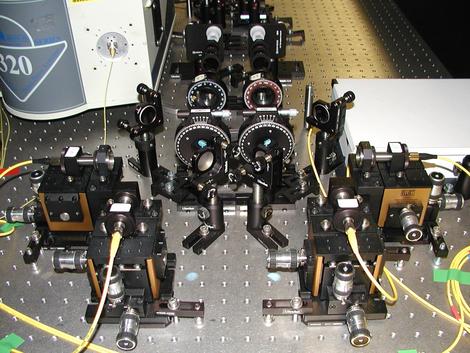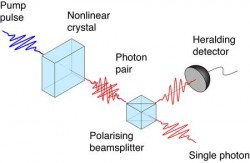Scientists at Oxford University have developed a method to generate the shortest ever single-photon pulse by removing the interference of quantum entanglement. So how big are these tiny record-breakers? They are 20 microns long (or 0.00002 metres), with a period of 65 femtoseconds (65 millionths of a billionth of a second). This experiment smashes the previous record for the shortest single-photon pulse; the Oxford photon is 50 times shorter. While this sounds pretty cool, what is all the fuss about? How can these tiny electromagnetic wave-particles be of any use? In two words: quantum computing. And in an additional three words: quantum satellite communications…
Quantum entanglement is a tough situation to put into words. In a nutshell: If a photon is absorbed by a type of material, two photons may be re-emitted. These two photons are of a lower energy than the original photon, but they are emitted from the same source and therefore entangled. This entangled pair is inextricably linked; regardless of the distance they are separated. Should the quantum state of one be changed, the other will experience that change. In theory, no matter how far away these photons are separated, the quantum change of one will communicated to the other instantly. Einstein called this quantum phenomenon “spooky action at a distance” and didn’t believe it possible, but experiment has proven otherwise.
So, in a recent publication, the Oxford group are trying to remove the entangled state of photons, this experiment isn’t about using this “spooky action”, it is to get rid of it. This is to remove the interference caused when one of the photon pair is detected. Once one of the twins is detected, the quantum state of the other is altered, contaminating the signal. If this effect can be removed, very short-period “pure” photons can be generated, heralding a new phase of quantum computing. If scientists have very definite, identical single photons at their disposal, highly accurate information can be carried with no interference from the quirky nature of quantum physics.
“Our technique minimises the effects of this entanglement, enabling us to prepare single photons that are extremely consistent and, to our knowledge, have the shortest duration of any photon ever generated. Not only is this a fascinating insight into fundamental physics but the precise timing and consistent attributes of these photons also makes them perfect for building photonic quantum logic gates and conducting experiments requiring large numbers of single photons.” – Peter Mosley, Co-Investigator, Oxford University.
The Oxford University blog reporting this news highlights how useful these regimented photons will be to quantum computing, quantum communications in space could also be a major benefactor. Imagine sending pulses of quantum-identical photons through space, to satellites at first, later through interplanetary space. Space scientists will have an extremely powerful resource so data can be sent though the vacuum, encrypted in a small number of photons, indecipherable to everything other than its destination…
Source: University of Oxford



chichi: “Implications” means “something that is inferred”, it can be a benefit or a drawback…
Dave: Yes, I believe that if there is “entanglement interference” there is a problem with corruption or loss of data. That’s pretty much it. However, I’m not totally convinced I understand this area of quantum physics that well… I’ll hopefully get a look at the paper and get the lowdown soon 🙂
Cheers, Ian
What are the “implications”? i only read benefits
Does this pose a problem of “lost information?” If the two photons are no longer entangled then it seems there is an information lost between the two..
And, yes, I have no idea what I am saying!
Ive heard something about this before.
Although Im not fully aware of the concept, I remember this being an incredibly secure way to code information, as well as updating it. If one photon is kept local and the other transmitted, information can be changed instantaneously, with the same effect coming out on the other end…particularily useful if the communication is intercepted
If the entanglement issues have been resolved, couldn’t this be used as a means of FTL communication?
Entanglement is not eliminated in the experiment. The observational affect is eliminated, thus making a wide variety of “implications” boggle the mind, indeed. Teleportation, although the end product might be two of the same individuals in separate places. My my. Could the Galaxy survive that many Captain Kirks?
More importantly, the on and off “statements” that are at the heart of the ones and zeros of digital information. Superluminal communication… that’s the first things that comes to mind… a real “Subspace Radio.”
Very exciting stuff ahead.
Somewhere, this very moment, someone is already inspired to be the first to hack Quanticryption. Implications indeed. The potential havoc weighs equally to the desired innovation. Still, that is how we learn. What a mindblowing boon to robotic exploration – amazing.
You are all missing the point severely. This is not about faster than light communications, nor is it about using entanglement to transmit information. This is about /NOT/ having entanglement so there’s no system to decohere and alter the state of the photons used for communications. Nor is this about encryption of any kind. It’s about having a cleaner signal, making communications more reliable. Think of this as eliminating the static in your radio so you can hear a station better. That’s all. While it’s good to be a dreamer, please don’t keep your heads so far in the clouds that you lose sight of the earth.
This looks very much like the ‘Orb’s’ in my Trilogy. Check out ‘Book Two’ of my work.
Thanks,
Robert Wilton Dale – Author
You can’t use entangled photons as a FTL transmitter. I’m not an expert, but I think that if you try, you just end up with a string of random numbers, which is obviously useless.
“They are 20 microns long (or 0.000001 metres)”
Hmm…
1 micron = 10^-6 metre
= 0.000001 metre
so 20 microns = 0.00002 metre
Thanks Gavin, can’t believe I didn’t see that mistake – Corrected now 🙂
Cheers, Ian
it sounds amazing.
Yes, this article is about single protons that could be transmitted at light speed as a clear signal. However, it’s not unrelated to think that FTL signals may be a consequence of our control over photonic communications. If one of an entangled pair is kept in stasis on Mars and the other on Earth, (and more likely several billion) then wouldn’t that facilitate an instantaneous way of data transmission? Simply modulate the quantum state of the protons and read the resulting states at the other end, keyed to a computer to make the translation. Course, that would refute one of Einsteins key conjectures, that nothing, including information could move more quickly than c. Maybe then we’d find that there was no movement and that the two particles are connected by quantum sized wormholes so that Einstein remains the “man”!
“Space scientists will have an extremely powerful resource so data can be sent though the vacuum, ”
Do you mean “through?”
This is also similar to “ansible communication” in Orson Scott Card’s “Ender’s Game” series and side series (“Ender’s Shadow” series).
I agree with Peter K above that while this is about clear signals, it also implies faster than light communication; and if it’s not implied then I believe we’re entirely misreading the point here. After all, communication can be communicated as data, and this is (if I have not misread) about clear communication. If we are reading this correctly, then in the next few decades or so (or much more or much less, it’s difficult to speculate with advancing technology) we will see an incredible leap in communications.
What does it mean “shortest ever single-photon pulse”? isn’t a single photon a single photon? How can one be longer than another? If this requires us to consider the wave properties of photons, does it mean the new record has 50X the wavelength or energy or something else? THanks.